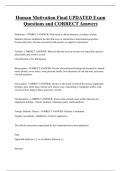Human Motivation Final UPDATED Exam
Questions and CORRECT Answers
Hedonism - CORRECT ANSWER- Motivated to obtain pleasure; avoidance of pain
Hedonic theories emphasize the idea that cues or stimuli have motivational properties
because they have become associated with positive or negative experiences
Troland - CORRECT ANSWER- Believed that the nervous system was especially tuned to
pleasurable and aversive events
Classification of for Stimulation
Beneception - CORRECT ANSWER- Occurs when pleasant feelings are aroused by stimuli-
erotic stimuli, sweet tastes, some pleasant smells, low intensities of salt and sour, and some
visceral responses
Nociception - CORRECT ANSWER- Occurs as the result of stimuli that arouse unpleasant
feelings- pain, bitter taste, intense salt, intense sour, nauseating or repugnant smells, cold,
excessive heat, hunger, thirst, and some visceral
Neutraception - CORRECT ANSWER- Exists when stimuli cause neither pleasant nor
unpleasant feelings - Vision, audition, cutaneous touch, and kinesthesis
Young's Hedonic Theory - CORRECT ANSWER- Hedonic Continuum
Negative (avoidant) <Indifferent> Positive (approach)
The affective processes represented by this continuum have three properties
Sign
Approach behavior (+) vs. Avoidance behavior (-)
Intensity
,Preference test given to determine affective intensity- in a two-choice situation, the chosen
substance is considered to be hedonically more intense than the nonchosen one
Duration
Some hedonic processes may last only as long as the sensory stimulation; others linger
Preference Test - CORRECT ANSWER- Given to determine affective intensity- in a two-
choice situation, the chosen substance is considered to be hedonically more intense than the
nonchosen one
Sensory Stimulation and The Hedonic Continumm - CORRECT ANSWER- Sensory stimuli
provide info to an organism about the conditions of its external and internal environment.
Affective processes, as represented by the hedonic continuum, convey little info other than
whether something is pleasant or unpleasant and, in choice situations, "better than" or "worse
than"
Young (1956)- Affective info is biologically primitive and are of a different order than the
more sophisticated discriminations we are capable of making from sensory information
the Hedonic continuum is not equivalent to sensory stimulation
Ex. As sugar water becomes more concentrated, we tend to prefer it over less concentrated
sugar solutions. However, when comparing distilled water and salty water, Young found that
his participants initially preferred the salty water. As the salt solution increased in
concentration, the preference changed to the distilled water
Therefore we cannot assume that changes in sensory intensity will initiate similar changes in
hedonic affect.
Pathological Pain States - CORRECT ANSWER- Pain Receptors
Pain normally occurs when the body is injured. Occasionally, the pain can often seem out of
proportion to the size of the injury
Phantom Limb Pain- Excruciating pain may be experienced even though the body part has
been amputated. In these cases, pain does not seem adaptive and may, in face, interfere with
more adaptive behaviors
, Melzack and Wall (1965)
Prior to their research, pain was thought to result from pain receptors sending their messages
along specific pain fibers to the brain.
However, the perception of pain was more variable and modifiable than originally thought
There is no simple and direct relationship between the severity of an injury and the amount of
pain experienced
Even pathological pain states such as causalgia (a burning pain that is sometimes caused by a
partial lesion of a peripheral nerve), peripheral neuralgia (which can occur following a
peripheral nerve infection), and phantom limb pain are often UNSUCCESSFULLY treated by
surgical lesions of either the central or peripheral nervous system.
if the experience of pain was simply the result of the stimulation of pain receptors, then
"disconnection" surgery should abolish the pain... but they often don't
The Gate Theory of Pain - CORRECT ANSWER- Melzack and Wall (1965)
Higher brain processes control the experience of pain
A modulating system within the spinal cord influences how much pain information reaches
the brain.
Basically, we have a neurological "gate" in our spinal cord
***Video***
Berlyne - CORRECT ANSWER- Argued that exploratory activity has the function of altering
the stimulus we receive rather than causing any changes to bodily tissues
Novelty and uncertainty motivate us by increasing the arousal level of the organism
We attempt to maintain an optimal level of arousal. If stimulation drops too low (as in
boredom), we become motivated to increase our level of arousal. If our arousal level is too
high, we are motivated to lower it.
Thus novel or surprising stimuli will usually motivate us because they provide small changes
in arousal that are usually pleasant (leading to optimal levels)
Novelty, Curiosity, and Exploratory Behavior - CORRECT ANSWER- External stimuli can
serve to motivate behavior directly
Terms used to describe the motive state generated by external stimuli include
Curiosity
Exploratory drive
Manipulations motives




